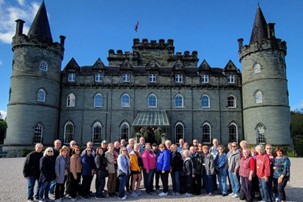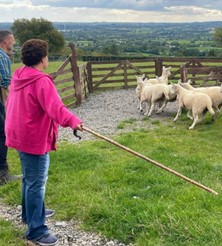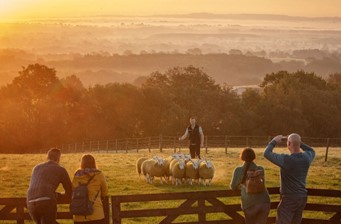 Every year for the past twenty years, Pam Jahnke, better known as the Fabulous Farm Babe, has hosted domestic and international farm tours.
Every year for the past twenty years, Pam Jahnke, better known as the Fabulous Farm Babe, has hosted domestic and international farm tours.
Inviting listeners to follow along on social media and in-person, bringing along approximately forty people, Jahnke and her tour group recently visited Scotland and Ireland, touring working dairies and sheep ranches.
“It was truly a unique experience to see sheep everywhere! Everyone in our group, except one couple from Texas, was from Wisconsin. Sheep aren’t as common at home,” Jahnke said.
As a farm broadcaster since 1988, Jahnke finds international producers through her work history and, of course, her trusty Rolodex. One such producer was Kieran O’Brien, a dairyman with 126 milk cows rotationally grazing in Clonee, Ireland.
“O’Brien had 185 acres but no corn or soybeans, which is very different than Wisconsin. His grass, however, was very high quality and high protein,” Jahnke added.
O’Brien is a fifth-generation farmer who’s expecting his teenagers to take over the family business one day. Jahnke’s group was very interested in asking specific market questions to a fellow industry member and were glad to hear prices weren’t bad and were incentivized in Ireland.
“He [O’Brien] is only 20 minutes from Dublin proper. It was wild to see land values going up and the urbanareas coming closer but not impacting his production yet,” Jahnke shared.
 During the 12-day tour, she said the group unexpectedly got a history lesson. The Queen of England passed away while they were in Scotland; her funeral was held during their time in Ireland.
During the 12-day tour, she said the group unexpectedly got a history lesson. The Queen of England passed away while they were in Scotland; her funeral was held during their time in Ireland.
“Americans get excited for a few hundred years of history, but they have thousands. We got to see that history firsthand in the making,” Jahnke recalled.
The group also toured the National Farm and Rural Life Museum, outside of Glasgow. The museum preserves ag heritage through a living history farm. The travelers had a chance to visit with its farm manager, Maggie, and learned how the museum will be entering a Clydesdale in the national Clydesdale contest in Ireland. She was also very proud of one of their Ayrshire cows that was classified EX-89. And again, there were always sheep.
“With four million sheep in Ireland, the trip wouldn’t be complete without talking to a flock owner. A well- rounded shepherd, Jamese McCloy, is an accomplished shearer and fourth-generation farmer,” described Jahnke.
McCloy owns forty acres along with a nice brace of border collies that help with rotational grazing. He has also launched an agro-tourism opportunity for visitors to find out what it’s like to be an Irish farmer – Glenshane Country Farm.
Jahnke also found lamb is very common on Irish restaurant menus, and plentiful in grocery stores.
“Whenever I go to another country, I make a point of going to local grocery stores to get a feeling for their emphasis on agriculture,” Jahnke added.
 One notable difference for Jahnke: how little space was used for dairy refrigeration. Grocery stores only seemed to stock as much milk as they would sell over several days, and then restocked.
One notable difference for Jahnke: how little space was used for dairy refrigeration. Grocery stores only seemed to stock as much milk as they would sell over several days, and then restocked.
Butterfat was another notable difference versus the United States. Here consumers are offered 2% milk. In Ireland milk containers routinely boasted 3.6% fat milk. Eggs are also generally brown in Ireland and not refrigerated according to Jahnke’s observations.
Next up for Jahnke will be leading a group to Iceland in March and to the Grand Tetons, Yosemite, and Glacier National Park in September. She has been a NAFB member since 1988.
